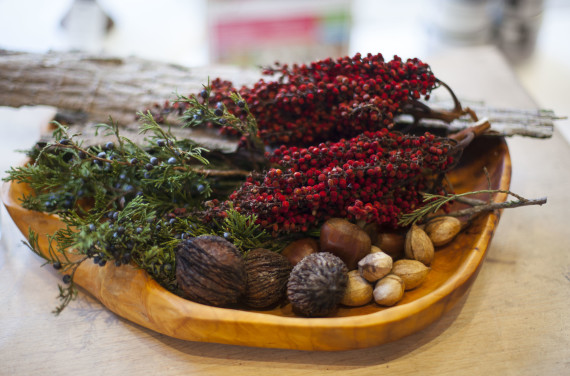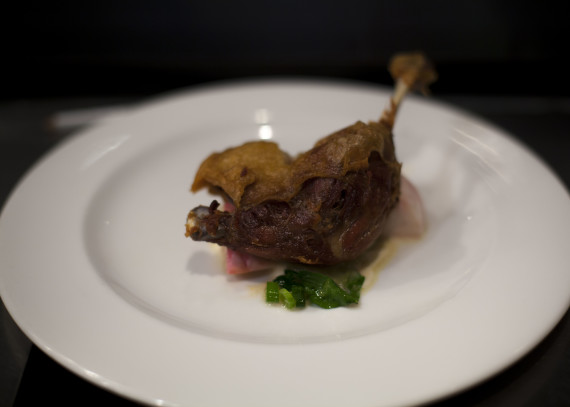Welcome to another edition of Tips & Tricks from the COOK Kitchen. Mardi Gras, Valentine’s Day and the cold weather filled the COOK kitchen with decadent, soul-warming cuisine. To bring February to a close I’ve compiled the best tips and tricks that I’ve heard from the chefs that graced our space this month. Read on and then go test these newfound skills for yourself!
Tip #1: Some Like It Hot… For Others, There’s Lemon Juice

This first tip is courtesy of Diana Sabater, three-time Chopped champion and owner of Diana’s Spice Cantina, and lover of spicy food. Diana and I started discussing our shared love for spicy peppers. Somewhere along our conversation I asked how she adapts to people that can’t handle the heat but still want to enjoy the flavor of the peppers. Diana quickly got excited to tell me about her trick to turn down the heat on any pepper. First, deseed your peppers of choice and then rinse them well. Next, place your washed peppers in a small bowl and cover with lemon juice. Let the peppers soak for 20 minutes and that’s it! The acidity from the lemon juice cuts the heat and makes it more palatable for milder palates. Lime juice works just as well.
Tip #2: Tree Bark Syrup

It can be tough to find fresh, locally grown ingredients during these late months of winter. That’s where Heather McMonnies comes in. Heather runs Food Hedge, which provides chefs with locally-foraged ingredients rarely seen in markets. For her foraged winter class Heather brought in an assortment of beautiful and wild items including sumac, hickory nuts, hickory bark, juniper branches, black walnuts and chestnuts. Heather shared a recipe for making cherry tree bark syrup, which she personally uses as homeopathic cough medicine for her kids. First, clean the bark by scrubbing it and washing with hot water. Let it dry and then put it in the oven on 125 degrees for 2.5 hours, flipping the bark halfway through toasting. Once done in the oven, let the bark cool and place it in a large pot. Add 12 cups of water per 1 pound of tree bark. Bring the pot to a slow boil and let it simmer for 2 hours. This basically is making a cherry tree bark tea which should be a hickory brown reddish color. Add sugar to sweeten, as well as to thicken to a syrup-like consistency. Add more or less sugar depending on your preference.
Tip #3: Duck On A Juniper Bed

Accompanying Heather McMonnies for their foraged-focused dinner was George Sabatino who recently took the Executive Chef position at Rooster Soup Co. Chef George Sabatino used Food Hedge’s wintry goods in very crafty ways. One dish in particular was exquisite, creatively incorporating the juniper branches that Heather brought. After deep frying the duck confit legs, George finished them in the oven on a wire rack on top of a sheet pan. The trick was that in between the wire rack and the bottom of the sheet pan was a bed of juniper branches. George explained that this allowed for the aroma from juniper branches to impart into the duck leg without direct contact.
Tip #4: Cajun Vegetable Holy Trinity

Looking to make some Cajun style food at home? Consider your veggies! COOK regular Nick Macri of La Divisa Meats put on a show with his four course Mardi Gras dinner. During the NOLA-inspired feast Nick shared the base of many Cajun dishes, including gumbo and jambalaya. Nick stated that you would be hard-pressed to not find the “holy trinity” in Louisiana kitchens: green bell peppers, celery, and onions. Think of it as the Cajun equivalent of the French mirepoix, which uses carrots in place of the bell pepper. For his Cajun boudin maque choux dish Nick sweated the holy trinity in a pan over medium heat and hit the vegetables with some salt to help release moisture. After that he added thyme and then corn and the corn starch from his blanching bowl. Nick also noted that when adding herbs to something like this be sure to add heavier herbs (i.e. thyme, rosemary) earlier in the cooking process. Alternatively, add fine herbs (i.e. parsley, basil) at the very end because if added too soon, their flavor will become muted in the dish.
Tip #5: Salt, Pepper, Steak

Lastly, Rich Freedman of The Olde Bar gave me his tip for seasoning and cooking steak. Rich was cooking for a private event at COOK and one of the guests was expressing his love for the Wagyu steak that Rich prepared. This prompted Rich to come over and say, “Thanks, you know what I seasoned it with? Salt and pepper”. At first I believed it was because Wagyu is such a fine cut of beef that it didn’t need any other flavors to be delicious, however Rich told me he seasons all his steaks with just salt and pepper. He noted that he only seasons it with salt at first and then once it is in the pan he finishes it with pepper at the end so that the pepper doesn’t burn in the hot pan.
Back to Blog



